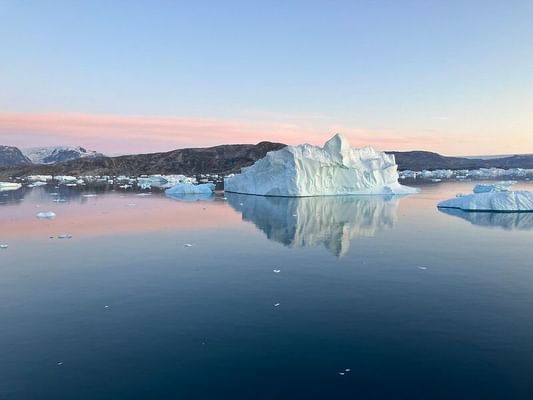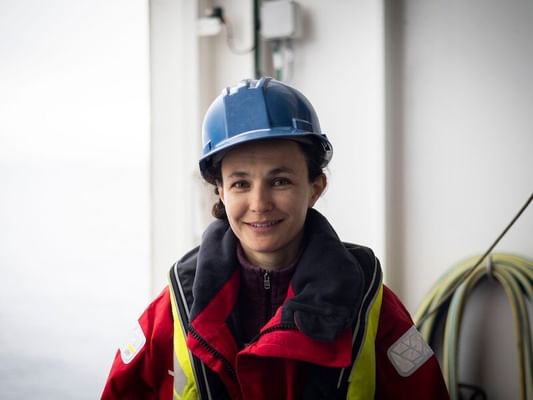- Undergraduate
Bachelor's Degrees
Bachelor of ArtsBachelor of EngineeringDual-Degree ProgramUndergraduate AdmissionsUndergraduate Experience
- Graduate
Graduate Experience
- Research
- Entrepreneurship
- Community
- About
-
Search
All Thayer News


Study Finds Highest Prediction of Sea-Level Rise Unlikely
Aug 21, 2024 | Dartmouth News
A new Dartmouth-led study reports that one of the worst-case projections of how high the world's oceans might rise as polar ice sheets melt is highly unlikely—though it stresses that the accelerating loss of ice from Greenland and Antarctica is nonetheless dire.

Professor Hélène Seroussi traveled to Greenland to study ice-sheet melting and sea-level rise. (Photo courtesy of Hélène Seroussi)
The study challenges a new and alarming prediction in the latest high-profile report from the United Nations' Intergovernmental Panel on Climate Change (IPCC) evaluating climate research and projecting the long- and near-term effects of the climate crisis. Released in full last year, the IPCC's sixth assessment report introduced a possible scenario in which the collapse of the southern continent's ice sheets would make Antarctica's contribution to average global sea level twice as high by 2100 than other models project—and three times as high by 2300.
Though the IPCC designated this specific prediction as "low likelihood," the potential of the world's oceans rising by as much as 50 feet as the model projects earned it a spot in the report. At that magnitude, the Florida Peninsula would be submerged, save for a strip of interior high ground spanning from Gainesville to north of Lake Okeechobee, with the state's coastal cities underwater.
But that prediction is based on a new hypothetical mechanism of how ice sheets—the thick, land-based glaciers covering polar regions—retreat and break apart. The mechanism, known as the Marine Ice Cliff Instability, has not been observed and has so far only been tested with a single low-resolution model, the Dartmouth researchers report in the journal Science Advances.
"We're not calling into question the standard, well-established projections that the IPCC's report is primarily based on. We're only calling into question this high-impact, low-likelihood projection that includes this new MICI process that is poorly understood."
Dartmouth Engineering Professor Hélène Seroussi

Associate Professor of Engineering Hélène Seroussi conducting field research in Greenland. (Photo by Alex Rivest)
The researchers instead tested MICI with three high-resolution models and an improved rate of ice collapse that more accurately capture the complex dynamics of ice sheets. They simulated the retreat of Antarctica's Thwaites Glacier, the 75-mile-wide ice sheet popularly nicknamed the "Doomsday Glacier" for the accelerating rate at which it is melting and its potential to raise global sea levels by more than two feet. Their models showed that even the imperiled Thwaites is unlikely to rapidly collapse during the 21st century as MICI would predict.
Mathieu Morlighem, professor of earth sciences and the paper's corresponding author, says that the findings suggest that the physics underlying the extreme projection included in the IPCC report are inaccurate, which can have real-world effects. Policymakers sometimes use these high-estimation models when considering the construction of physical barriers such as sea walls or even relocating people who live in low-lying areas, Morlighem says.
"These projections are actually changing people's lives. Policymakers and planners rely on these models, and they’re frequently looking at the high-end risk. They don't want to design solutions and then the threat turns out to be even worse than they thought," Morlighem says.
"We're not reporting that the Antarctic is safe and that sea-level rise isn't going to continue—all of our projections show a rapid retreat of the ice sheet," he continues. "But high-end projections are important for coastal planning, and we want them to be accurate in terms of physics. In this case, we know this extreme projection is unlikely over the course of the 21st century."
Morlighem worked with Dartmouth Engineering Professor Hélène Seroussi, along with researchers from the University of Michigan, the University of Edinburgh and the University of St. Andrews in Scotland, and Northumbria University and the University of Stirling in England.
The idea behind MICI is that if an ice shelf—the floating extension of the land-based ice sheet—collapses rapidly, it would potentially leave the ice cliffs that form the outer edge of the ice sheet exposed and unsupported. If these cliffs are tall enough, they would break under their own weight, exposing an even taller cliff and leading to rapid retreat as the ice sheet collapses inward toward the interior like a row of dominos. The loss of this ice into the ocean where it would melt is what would lead to the projected dramatic sea-level rise.
But the authors of the Science Advances study find that the glacial collapse is not that simple or that fast. "Everyone agrees that cliff failure is real—a cliff will collapse if it’s too tall. The question is how fast that will happen," Morlighem says. "But we found that the rate of retreat is nowhere near as high as what was assumed in these initial simulations. When we use a rate that is better constrained by physics, we see that ice cliff instability never kicks in."
The researchers focused on Thwaites Glacier because it has been identified as especially vulnerable to collapse as its supporting ice shelf continues to break down. The researchers used a computer model based on the physics of how ice melts and moves to simulate Thwaites' retreat for 100 years following a sudden hypothetical collapse of its ice shelf, as well as for 50 years under the rate of retreat actually underway.
In all their simulations, the researchers found that Thwaites' ice cliffs never retreated inland at the speed MICI suggests. Instead, without the ice shelf holding the ice sheet back, the movement of the glacier toward the ocean accelerates rapidly, causing the ice sheet to expand away from the interior. This accelerated movement also thins the ice at the glacier's edge, which reduces the height of the ice cliffs and their susceptibility to collapse.
"We're not calling into question the standard, well-established projections that the IPCC’s report is primarily based on," Seroussi says. "We're only calling into question this high-impact, low-likelihood projection that includes this new MICI process that is poorly understood. Other known instabilities in the polar ice sheets are still going to play a role in their loss in the coming decades and centuries."
Polar ice sheets are, for example, vulnerable to the established Marine Ice Sheet Instability, says study co-author Dan Goldberg, a glaciologist at Edinburgh who was a visiting professor at Dartmouth when the project began. MISI predicts that, without the protection of ice shelves, a glacier resting on a submerged continent that slopes downward toward the interior of the ice sheet will retreat unstably. This process is expected to accelerate ice loss and contribute increasingly to sea-level rise, Goldberg says.
"While we did not observe MICI in the 21st century, this was in part because of processes that can lead to the MISI," Goldberg says. "In any case, Thwaites is likely to retreat unstably in the coming centuries, which underscores the need to better understand how the glacier will respond to ocean warming and ice-shelf collapse through ongoing modeling and observation."
Link to source:
https://home.dartmouth.edu/news/2024/08/study-finds-highest-prediction-sea-level-rise-unlikely
For contacts and other media information visit our Media Resources page.
